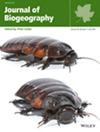Species evenness-area relationships in fragmented landscapes
Abstract
Aims
The relationship between habitat area and species evenness quantifies species relative abundance distribution changes across habitat fragments, providing more information than considering only the species richness to predict biodiversity distribution patterns in fragmented landscapes. However, unlike the species-area relationships (SARs), the Species Evenness-Area Relationship (SEARs) has yet to be explored across taxa at a large spatial scale. Here, we resolved how the relationship between species evenness and fragment area varies among taxonomic groups and environmental factors.
Location
Global.
Taxa
Insecta, Aves, Amphibians and Squamata, Plantae, Arachnida, Mammalia, Mollusca.
Methods
We compiled 67 datasets from the FragSAD database, including information on fragments area, species richness, and species abundance of six taxa worldwide. We calculated the species evenness index for each fragment, which is independent of species richness, and tested the relationship between species evenness and fragment area across taxonomic groups. We also used the power model to fit SEAR for each dataset and identified landscape variables with a detectable impact on the occurrence of significant SEARs.
Results
In contrast to the positive relationship between species richness and fragment area, species evenness was negatively affected by fragment area when controlling for other environmental factors and the relationships varied significantly among taxonomic groups. Specifically, there were significant negative associations between species evenness and fragment area for insects, birds, spiders, and mammals but not for plants and amphibians. Meanwhile, the occurrence of significant SEARs depends on the number of fragments and total fragment area.
Main Conclusions
The contrasting patterns of SEARs and SARs among taxonomic groups highlight the complexity of the mechanisms regulating biodiversity patterns. Although the number of species increases with the increase of fragment area, the decreased evenness implies community instability on larger fragments. Therefore, understanding the prevalence and underlying mechanisms in determining SEARs has critical implications for biodiversity conservation.

 求助内容:
求助内容: 应助结果提醒方式:
应助结果提醒方式:


